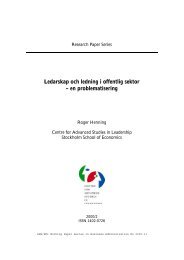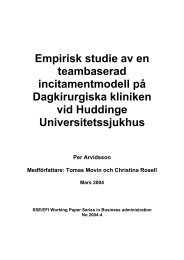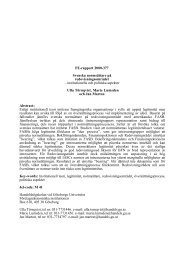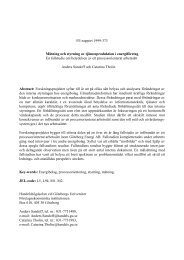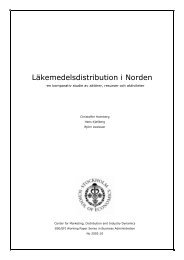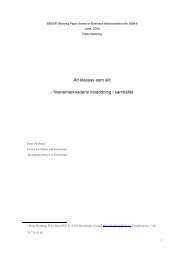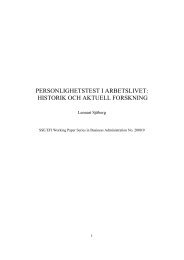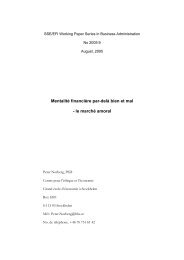Big Five Plus - S-WoBA - Handelshögskolan i Stockholm
Big Five Plus - S-WoBA - Handelshögskolan i Stockholm
Big Five Plus - S-WoBA - Handelshögskolan i Stockholm
You also want an ePaper? Increase the reach of your titles
YUMPU automatically turns print PDFs into web optimized ePapers that Google loves.
72. Frost, R. O., Marten, P., Lahart, C., & Rosenblate, R. (1990). The dimensions of perfectionism.<br />
Cognitive Therapy and Research, 14, 449-468.<br />
73. Funder, D. C. (1991). Global traits: A neo-Allportian approach to personality. Psychological<br />
Science, 2, 31-39.<br />
74. Furnham, A. (1986). Response bias, social desirability and dissimulation. Personality &<br />
Individual Differences, 7(3), 385-400.<br />
75. Føllesdal, H., & Hagtvet, K. A. (in press). Emotional intelligence: The MSCEIT from the<br />
perspective of generalizability theory. Intelligence.<br />
76. Garb, H. N., Florio, C. M., & Grove, W. M. (1998). The validity of the Rorschach and the<br />
Minnesota Multiphasic Personality Inventory: Results from meta-analyses. Psychological<br />
Science, 9, 402-404.<br />
77. Gladwell, M. (2005). Blink. The power of thinking without thinking. New Your: Little,<br />
Brown.<br />
78. Goldberg, L. R. (1968). Simple models or simple processes? Some research on clinical<br />
judgments. American Psychologist, 23, 483-496.<br />
79. Goldberg, L. R. (1970). Man versus model of man: A rationale plus some evidence for a<br />
method of improving clinical inferences. Psychological Bulletin, 73, 422-432.<br />
80. Goldberg, L. R., & Saucier, G. (1995). So what do you propose we use instead? A reply to<br />
Block. Psychological Bulletin, 117(2), 221-225.<br />
81. Goleman, D. (1995). Emotional intelligence. New York: Bantam Books.<br />
82. Gosling, S. D., Rentfrow, P. J., & Swann, W. B. J. (2003). A very brief measure of the<br />
<strong>Big</strong>-<strong>Five</strong> personality domains. Journal of Research in Personality, 37, 504-528.<br />
83. Grawitch, M. J., Trares, S., & Kohler, J. M. (2007). Healthy workplace practices and employee<br />
outcomes. International Journal of Stress Management, 14, 275-293.<br />
84. Grove, W. M., & Meehl, P. E. (1996). Comparative efficiency of informal (subjective,<br />
impressionistic) and formal (mechanical, algorithmic) prediction procedures: The clinical-statistical<br />
controversy. Psychology, Public Policy, and Law, 2, 293-323.<br />
85. Guenole, N., & Chernyshenko, O. S. (2005). The Suitability of Goldberg's <strong>Big</strong> <strong>Five</strong> IPIP<br />
Personality Markers in New Zealand: A Dimensionality, Bias, and Criterion Validity<br />
Evaluation. New Zealand Journal of Psychology, 34(2), 86-96.<br />
86. Guilford, J. P. (1950). Creativity. American Psychologist, 5, 444-454.<br />
87. Harland, L. K. (2003). Using Personality Tests in Leadership Development: Test Format<br />
Effects and the Mitigating Impact of Explanations and Feedback. Human Resource<br />
Development Quarterly, 14(3), 285-301.<br />
156



